Australia's Justice System: TJ, RJ, and Mental Diagnosis Analysis
VerifiedAdded on 2023/04/21
|6
|1249
|131
Homework Assignment
AI Summary
This assignment analyzes the potential strengths and weaknesses of Therapeutic Jurisprudence (TJ) and Restorative Justice (RJ) within Australia's correctional system, referencing De Freitas's work and other scholarly sources. It examines how TJ and RJ could improve the Australian justice system, considering the country's existing legal framework and cultural context. The assignment also explores the advantages and disadvantages of mental diagnosis, as discussed in a video, considering factors like standardization, access to treatment, and the impact of labeling and stigma. It highlights both the benefits of diagnosis in providing appropriate care and research, and the potential drawbacks, including the limitations of diagnostic processes, potential for stigmatization, and the failure to explain the causes of mental illness. The assignment uses resources such as Warren (2012) and the documentary 'How Mad Are You?' to support its analysis.
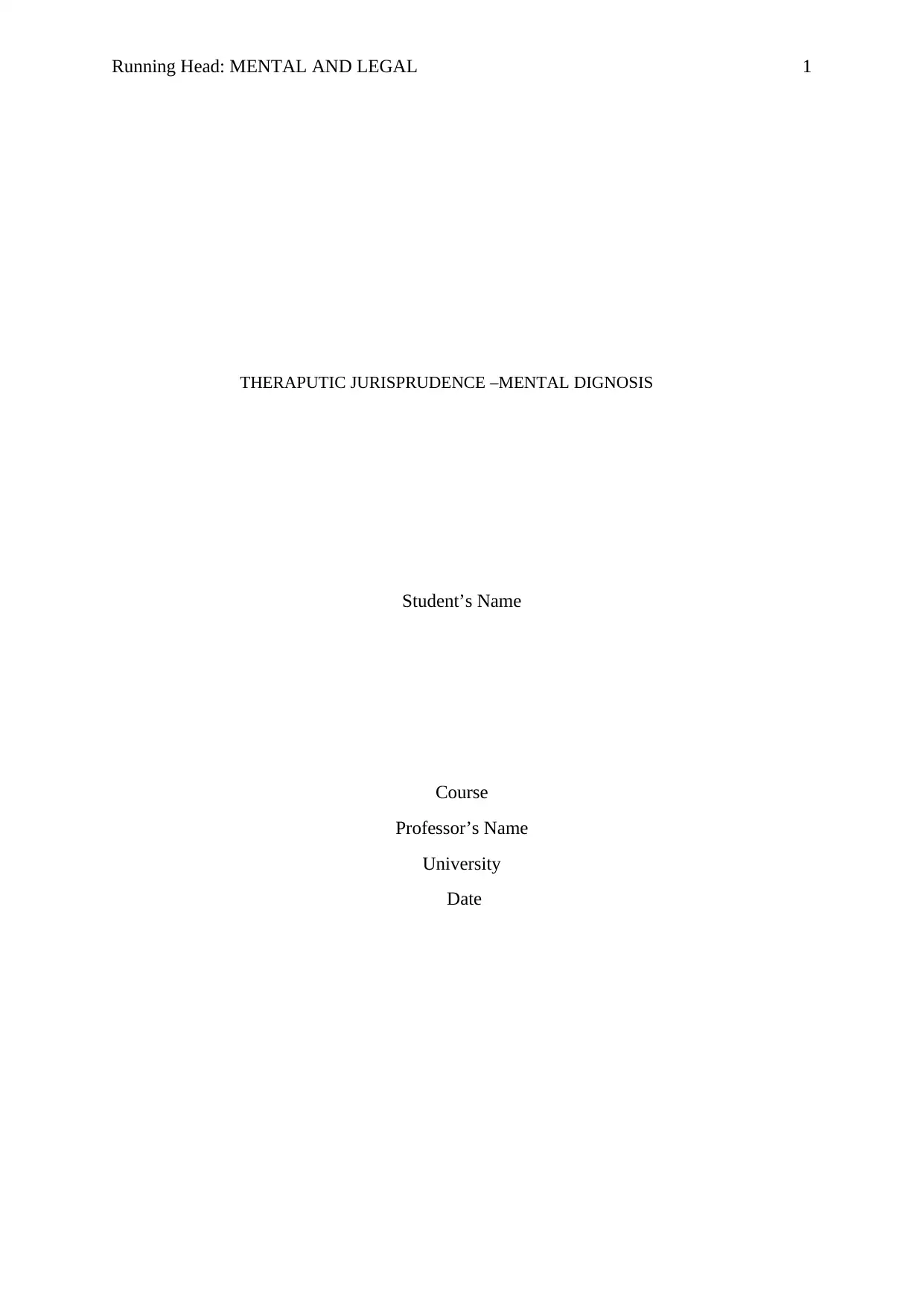
Running Head: MENTAL AND LEGAL 1
THERAPUTIC JURISPRUDENCE –MENTAL DIGNOSIS
Student’s Name
Course
Professor’s Name
University
Date
THERAPUTIC JURISPRUDENCE –MENTAL DIGNOSIS
Student’s Name
Course
Professor’s Name
University
Date
Paraphrase This Document
Need a fresh take? Get an instant paraphrase of this document with our AI Paraphraser
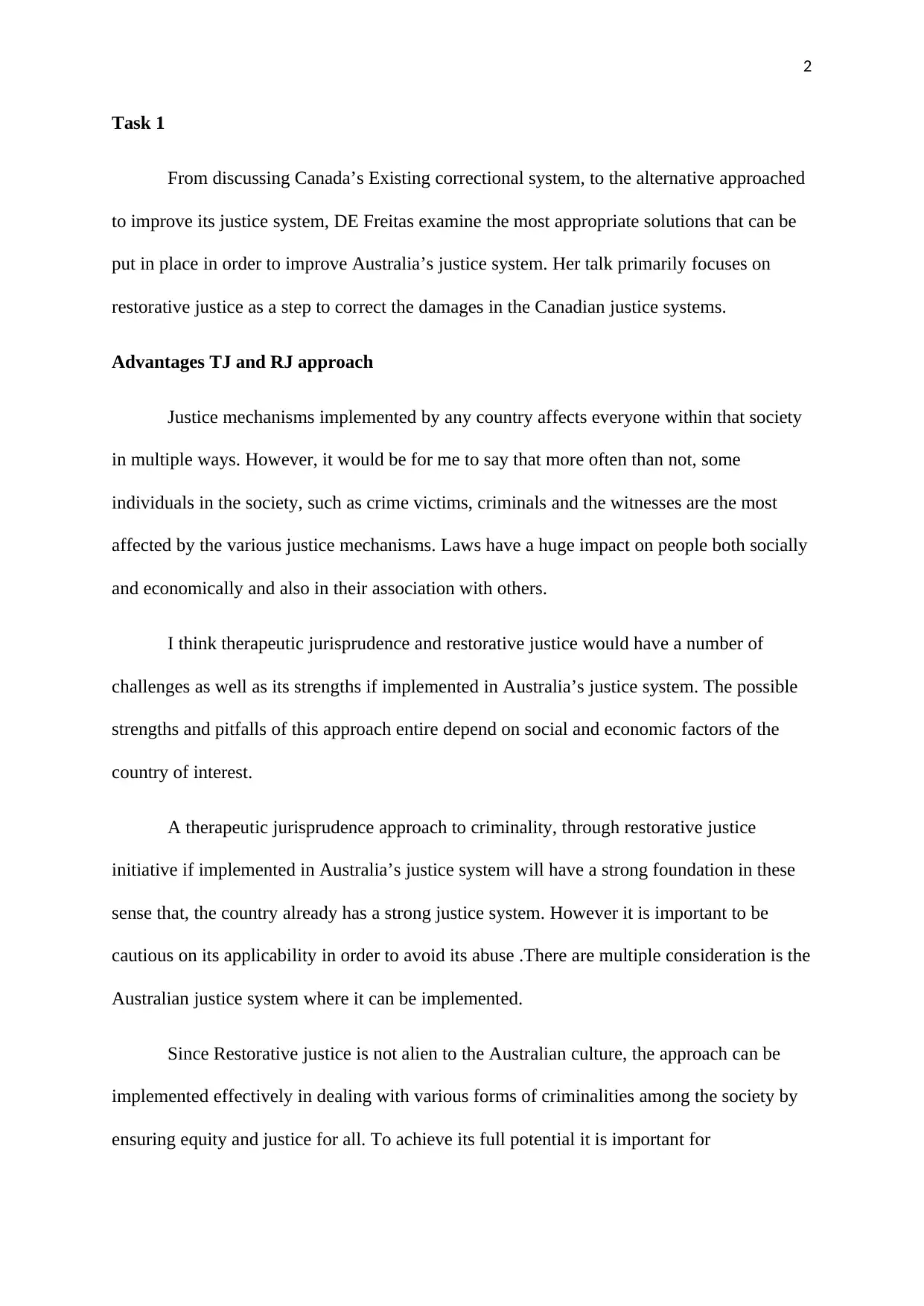
2
Task 1
From discussing Canada’s Existing correctional system, to the alternative approached
to improve its justice system, DE Freitas examine the most appropriate solutions that can be
put in place in order to improve Australia’s justice system. Her talk primarily focuses on
restorative justice as a step to correct the damages in the Canadian justice systems.
Advantages TJ and RJ approach
Justice mechanisms implemented by any country affects everyone within that society
in multiple ways. However, it would be for me to say that more often than not, some
individuals in the society, such as crime victims, criminals and the witnesses are the most
affected by the various justice mechanisms. Laws have a huge impact on people both socially
and economically and also in their association with others.
I think therapeutic jurisprudence and restorative justice would have a number of
challenges as well as its strengths if implemented in Australia’s justice system. The possible
strengths and pitfalls of this approach entire depend on social and economic factors of the
country of interest.
A therapeutic jurisprudence approach to criminality, through restorative justice
initiative if implemented in Australia’s justice system will have a strong foundation in these
sense that, the country already has a strong justice system. However it is important to be
cautious on its applicability in order to avoid its abuse .There are multiple consideration is the
Australian justice system where it can be implemented.
Since Restorative justice is not alien to the Australian culture, the approach can be
implemented effectively in dealing with various forms of criminalities among the society by
ensuring equity and justice for all. To achieve its full potential it is important for
Task 1
From discussing Canada’s Existing correctional system, to the alternative approached
to improve its justice system, DE Freitas examine the most appropriate solutions that can be
put in place in order to improve Australia’s justice system. Her talk primarily focuses on
restorative justice as a step to correct the damages in the Canadian justice systems.
Advantages TJ and RJ approach
Justice mechanisms implemented by any country affects everyone within that society
in multiple ways. However, it would be for me to say that more often than not, some
individuals in the society, such as crime victims, criminals and the witnesses are the most
affected by the various justice mechanisms. Laws have a huge impact on people both socially
and economically and also in their association with others.
I think therapeutic jurisprudence and restorative justice would have a number of
challenges as well as its strengths if implemented in Australia’s justice system. The possible
strengths and pitfalls of this approach entire depend on social and economic factors of the
country of interest.
A therapeutic jurisprudence approach to criminality, through restorative justice
initiative if implemented in Australia’s justice system will have a strong foundation in these
sense that, the country already has a strong justice system. However it is important to be
cautious on its applicability in order to avoid its abuse .There are multiple consideration is the
Australian justice system where it can be implemented.
Since Restorative justice is not alien to the Australian culture, the approach can be
implemented effectively in dealing with various forms of criminalities among the society by
ensuring equity and justice for all. To achieve its full potential it is important for
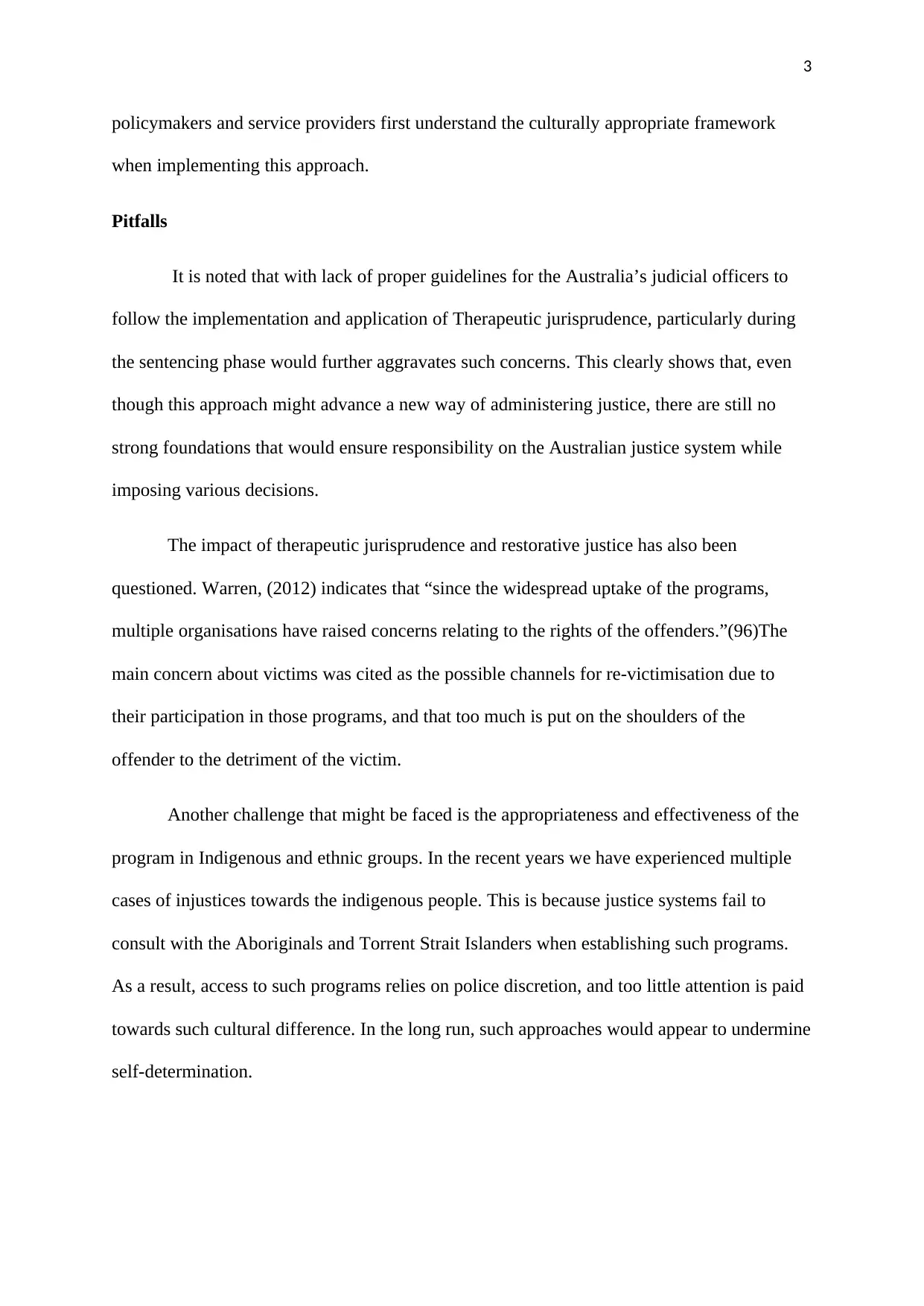
3
policymakers and service providers first understand the culturally appropriate framework
when implementing this approach.
Pitfalls
It is noted that with lack of proper guidelines for the Australia’s judicial officers to
follow the implementation and application of Therapeutic jurisprudence, particularly during
the sentencing phase would further aggravates such concerns. This clearly shows that, even
though this approach might advance a new way of administering justice, there are still no
strong foundations that would ensure responsibility on the Australian justice system while
imposing various decisions.
The impact of therapeutic jurisprudence and restorative justice has also been
questioned. Warren, (2012) indicates that “since the widespread uptake of the programs,
multiple organisations have raised concerns relating to the rights of the offenders.”(96)The
main concern about victims was cited as the possible channels for re-victimisation due to
their participation in those programs, and that too much is put on the shoulders of the
offender to the detriment of the victim.
Another challenge that might be faced is the appropriateness and effectiveness of the
program in Indigenous and ethnic groups. In the recent years we have experienced multiple
cases of injustices towards the indigenous people. This is because justice systems fail to
consult with the Aboriginals and Torrent Strait Islanders when establishing such programs.
As a result, access to such programs relies on police discretion, and too little attention is paid
towards such cultural difference. In the long run, such approaches would appear to undermine
self-determination.
policymakers and service providers first understand the culturally appropriate framework
when implementing this approach.
Pitfalls
It is noted that with lack of proper guidelines for the Australia’s judicial officers to
follow the implementation and application of Therapeutic jurisprudence, particularly during
the sentencing phase would further aggravates such concerns. This clearly shows that, even
though this approach might advance a new way of administering justice, there are still no
strong foundations that would ensure responsibility on the Australian justice system while
imposing various decisions.
The impact of therapeutic jurisprudence and restorative justice has also been
questioned. Warren, (2012) indicates that “since the widespread uptake of the programs,
multiple organisations have raised concerns relating to the rights of the offenders.”(96)The
main concern about victims was cited as the possible channels for re-victimisation due to
their participation in those programs, and that too much is put on the shoulders of the
offender to the detriment of the victim.
Another challenge that might be faced is the appropriateness and effectiveness of the
program in Indigenous and ethnic groups. In the recent years we have experienced multiple
cases of injustices towards the indigenous people. This is because justice systems fail to
consult with the Aboriginals and Torrent Strait Islanders when establishing such programs.
As a result, access to such programs relies on police discretion, and too little attention is paid
towards such cultural difference. In the long run, such approaches would appear to undermine
self-determination.
⊘ This is a preview!⊘
Do you want full access?
Subscribe today to unlock all pages.

Trusted by 1+ million students worldwide
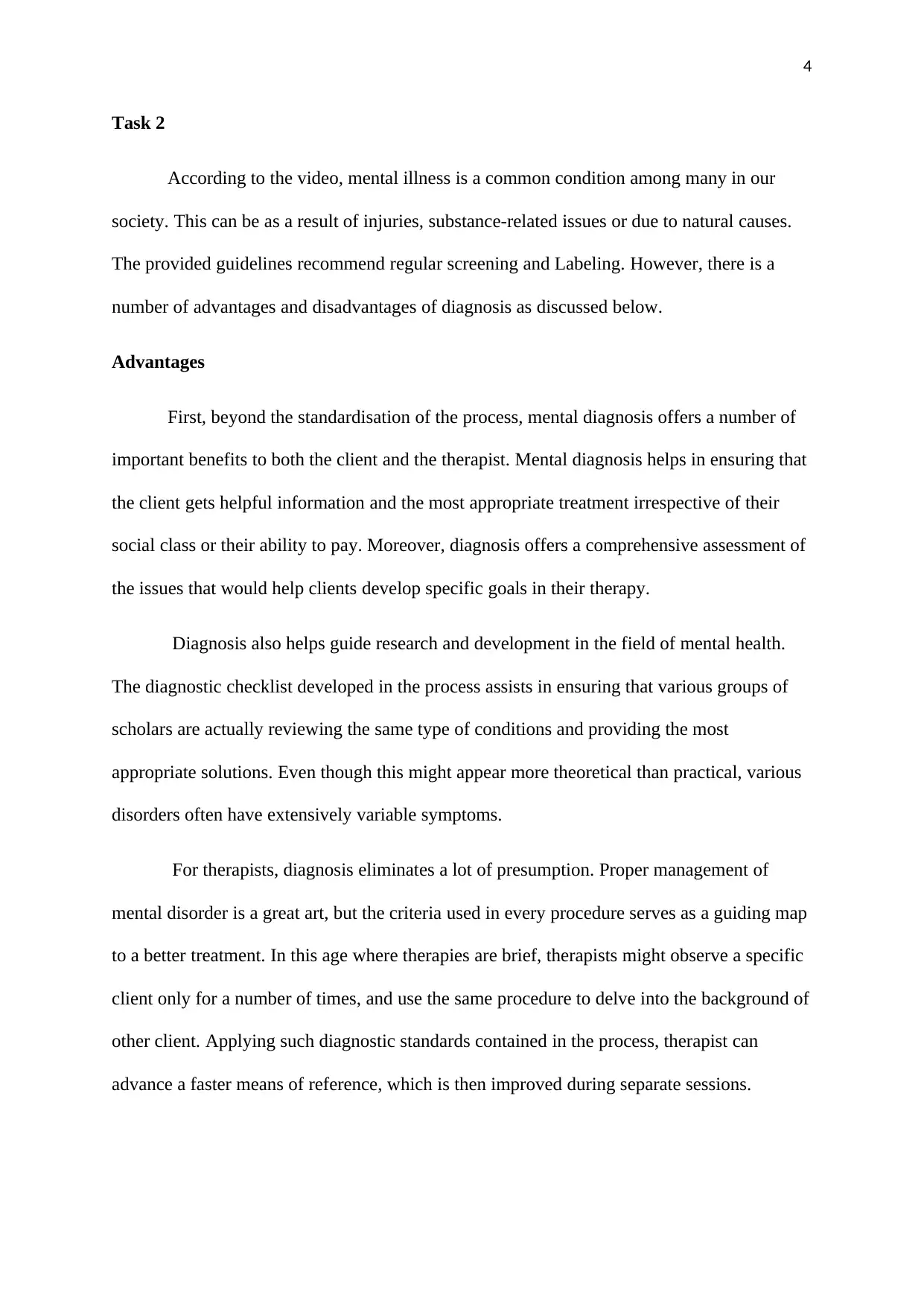
4
Task 2
According to the video, mental illness is a common condition among many in our
society. This can be as a result of injuries, substance-related issues or due to natural causes.
The provided guidelines recommend regular screening and Labeling. However, there is a
number of advantages and disadvantages of diagnosis as discussed below.
Advantages
First, beyond the standardisation of the process, mental diagnosis offers a number of
important benefits to both the client and the therapist. Mental diagnosis helps in ensuring that
the client gets helpful information and the most appropriate treatment irrespective of their
social class or their ability to pay. Moreover, diagnosis offers a comprehensive assessment of
the issues that would help clients develop specific goals in their therapy.
Diagnosis also helps guide research and development in the field of mental health.
The diagnostic checklist developed in the process assists in ensuring that various groups of
scholars are actually reviewing the same type of conditions and providing the most
appropriate solutions. Even though this might appear more theoretical than practical, various
disorders often have extensively variable symptoms.
For therapists, diagnosis eliminates a lot of presumption. Proper management of
mental disorder is a great art, but the criteria used in every procedure serves as a guiding map
to a better treatment. In this age where therapies are brief, therapists might observe a specific
client only for a number of times, and use the same procedure to delve into the background of
other client. Applying such diagnostic standards contained in the process, therapist can
advance a faster means of reference, which is then improved during separate sessions.
Task 2
According to the video, mental illness is a common condition among many in our
society. This can be as a result of injuries, substance-related issues or due to natural causes.
The provided guidelines recommend regular screening and Labeling. However, there is a
number of advantages and disadvantages of diagnosis as discussed below.
Advantages
First, beyond the standardisation of the process, mental diagnosis offers a number of
important benefits to both the client and the therapist. Mental diagnosis helps in ensuring that
the client gets helpful information and the most appropriate treatment irrespective of their
social class or their ability to pay. Moreover, diagnosis offers a comprehensive assessment of
the issues that would help clients develop specific goals in their therapy.
Diagnosis also helps guide research and development in the field of mental health.
The diagnostic checklist developed in the process assists in ensuring that various groups of
scholars are actually reviewing the same type of conditions and providing the most
appropriate solutions. Even though this might appear more theoretical than practical, various
disorders often have extensively variable symptoms.
For therapists, diagnosis eliminates a lot of presumption. Proper management of
mental disorder is a great art, but the criteria used in every procedure serves as a guiding map
to a better treatment. In this age where therapies are brief, therapists might observe a specific
client only for a number of times, and use the same procedure to delve into the background of
other client. Applying such diagnostic standards contained in the process, therapist can
advance a faster means of reference, which is then improved during separate sessions.
Paraphrase This Document
Need a fresh take? Get an instant paraphrase of this document with our AI Paraphraser
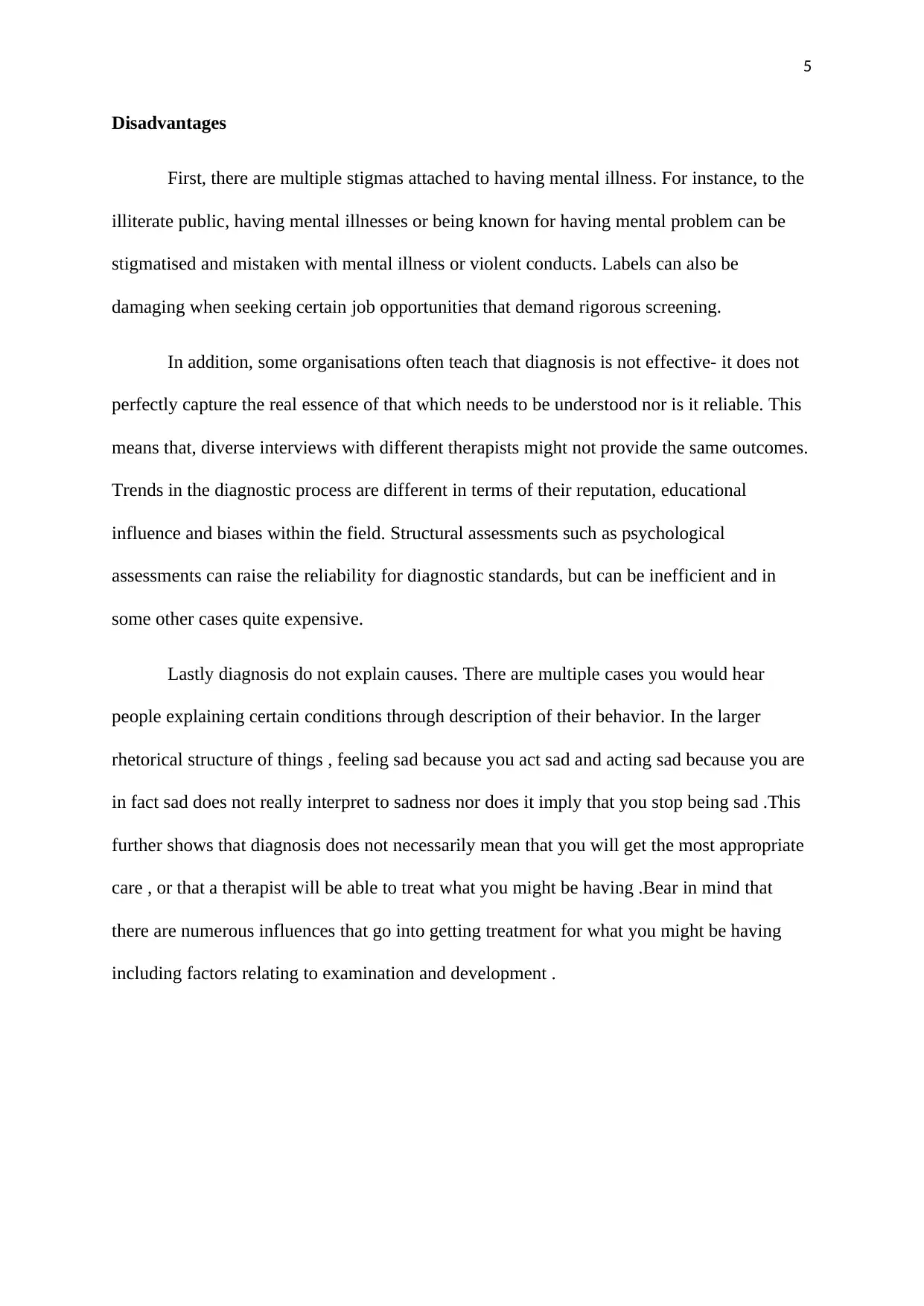
5
Disadvantages
First, there are multiple stigmas attached to having mental illness. For instance, to the
illiterate public, having mental illnesses or being known for having mental problem can be
stigmatised and mistaken with mental illness or violent conducts. Labels can also be
damaging when seeking certain job opportunities that demand rigorous screening.
In addition, some organisations often teach that diagnosis is not effective- it does not
perfectly capture the real essence of that which needs to be understood nor is it reliable. This
means that, diverse interviews with different therapists might not provide the same outcomes.
Trends in the diagnostic process are different in terms of their reputation, educational
influence and biases within the field. Structural assessments such as psychological
assessments can raise the reliability for diagnostic standards, but can be inefficient and in
some other cases quite expensive.
Lastly diagnosis do not explain causes. There are multiple cases you would hear
people explaining certain conditions through description of their behavior. In the larger
rhetorical structure of things , feeling sad because you act sad and acting sad because you are
in fact sad does not really interpret to sadness nor does it imply that you stop being sad .This
further shows that diagnosis does not necessarily mean that you will get the most appropriate
care , or that a therapist will be able to treat what you might be having .Bear in mind that
there are numerous influences that go into getting treatment for what you might be having
including factors relating to examination and development .
Disadvantages
First, there are multiple stigmas attached to having mental illness. For instance, to the
illiterate public, having mental illnesses or being known for having mental problem can be
stigmatised and mistaken with mental illness or violent conducts. Labels can also be
damaging when seeking certain job opportunities that demand rigorous screening.
In addition, some organisations often teach that diagnosis is not effective- it does not
perfectly capture the real essence of that which needs to be understood nor is it reliable. This
means that, diverse interviews with different therapists might not provide the same outcomes.
Trends in the diagnostic process are different in terms of their reputation, educational
influence and biases within the field. Structural assessments such as psychological
assessments can raise the reliability for diagnostic standards, but can be inefficient and in
some other cases quite expensive.
Lastly diagnosis do not explain causes. There are multiple cases you would hear
people explaining certain conditions through description of their behavior. In the larger
rhetorical structure of things , feeling sad because you act sad and acting sad because you are
in fact sad does not really interpret to sadness nor does it imply that you stop being sad .This
further shows that diagnosis does not necessarily mean that you will get the most appropriate
care , or that a therapist will be able to treat what you might be having .Bear in mind that
there are numerous influences that go into getting treatment for what you might be having
including factors relating to examination and development .
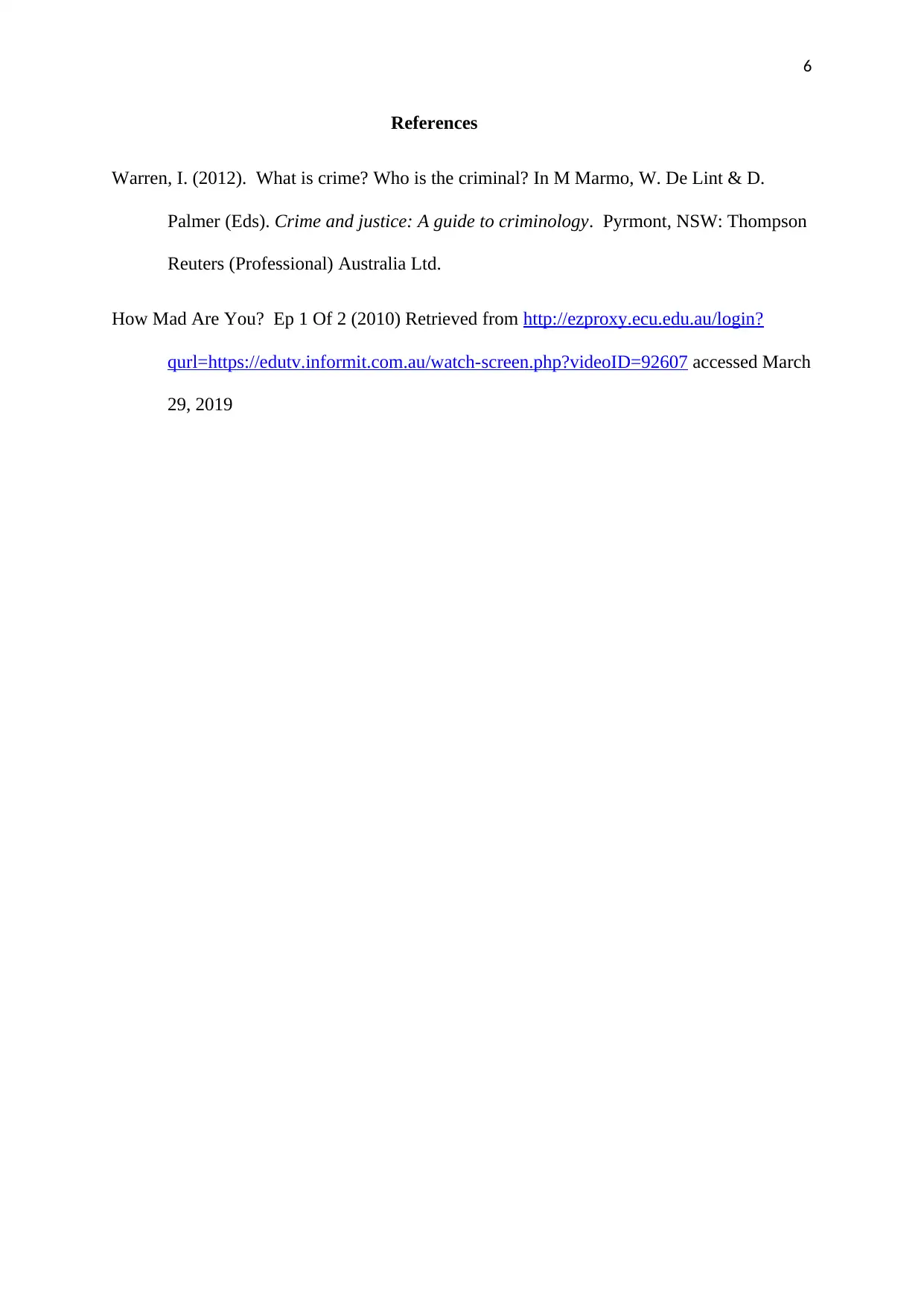
6
References
Warren, I. (2012). What is crime? Who is the criminal? In M Marmo, W. De Lint & D.
Palmer (Eds). Crime and justice: A guide to criminology. Pyrmont, NSW: Thompson
Reuters (Professional) Australia Ltd.
How Mad Are You? Ep 1 Of 2 (2010) Retrieved from http://ezproxy.ecu.edu.au/login?
qurl=https://edutv.informit.com.au/watch-screen.php?videoID=92607 accessed March
29, 2019
References
Warren, I. (2012). What is crime? Who is the criminal? In M Marmo, W. De Lint & D.
Palmer (Eds). Crime and justice: A guide to criminology. Pyrmont, NSW: Thompson
Reuters (Professional) Australia Ltd.
How Mad Are You? Ep 1 Of 2 (2010) Retrieved from http://ezproxy.ecu.edu.au/login?
qurl=https://edutv.informit.com.au/watch-screen.php?videoID=92607 accessed March
29, 2019
⊘ This is a preview!⊘
Do you want full access?
Subscribe today to unlock all pages.

Trusted by 1+ million students worldwide
1 out of 6
Related Documents
Your All-in-One AI-Powered Toolkit for Academic Success.
+13062052269
info@desklib.com
Available 24*7 on WhatsApp / Email
![[object Object]](/_next/static/media/star-bottom.7253800d.svg)
Unlock your academic potential
Copyright © 2020–2025 A2Z Services. All Rights Reserved. Developed and managed by ZUCOL.





